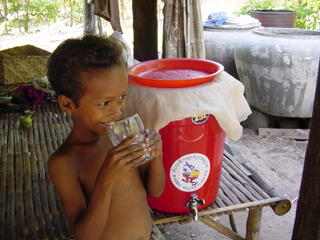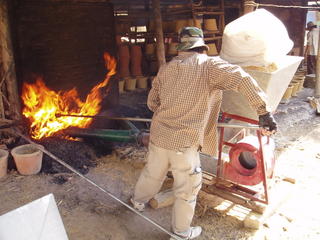All of International Development in 1800 Word or Less: The CWP Project
Sustainability is one of the biggest buzzwords in International Development. There’s a reason for this. The plains of Africa are littered with rusting tractors transported there by good intentions but maintained with empty promises. The migration that started the slashing and burning of the South American rainforests began over twenty years ago with a Brazilian government project to move the poor out of the way of progress in one place and into a supposedly better life in another. There are similar stories here in Cambodia. A project to bring infrastructure, water, sanitation, or education to a community is a great idea in theory but one of the first questions asked should always be, “Once we’re gone, will it still be here?”
The second question after this one is, “If it is still here, is that necessarily a good thing?”
To answer the first question positively, aid agencies and donors alike have become expert at sifting through census data, analyzing and re-analyzing socio-economic indicators, and offering their predictions in the form of reports. Unfortunately, often enough the net result of all these reports is a project that takes into account every detail except one: Who will maintain the hydroelectric dam, latrines, schoolhouse, or water treatment plant after the donations stop?
If there’s no satisfactory solution to this problem, everyone involved scratches their heads and tries to think of one, promising that as soon as a good answer is found, the need for external funding will end. This can continue indefinitely with no solution in sight. In international development terms, it’s called "Creating a Dependency." It’s the charitable equivalent of a man in an alley saying, “Psst. No worries. The first hydroelectric dam’s free.” It’s how they get you hooked.
Assuming this first problem can be resolved, the second question is a little more subtle. Getting a project to be self-sustaining can take years. In the meantime one needs to ask, what will be its effects? That unexpected consequences will crop up is virtually guaranteed. Wrapped up in terms like “Gender Empowerment”, “Education”, and “Pro-Poor”, an international development project is more often than not a politically correct exercise in social engineering, directed by a group of influential foreigners with at best, a limited understanding of the society that they’re trying to tweak. With colonialism supposedly behind us, this alone should give pause for thought.
Enter the Business Services Development (BSD) approach. A fancy acronym in a sea of fancy acronyms, it expresses the idea that by training people to manage businesses whose products and services are affordable to the very poor, wealth can be generated and expanded even among those with almost no purchasing power. Better still, instead of rusting tractors that no one has the resources to maintain, these goods and services can support themselves.
It’s an interesting idea, especially in light of the two questions above. Instead of dictating a future in which they have no say to a faceless mass of poor people, this offers them the opportunity to use the resources they have, limited though they may be, to begin choosing their own path. They can choose to be entrepreneurs. They can choose to use their purchasing power to invest in the resources around them. In short, they can start to build their own way out of poverty without outside interference.
All of this sounds great in theory. The problem of course in practice is that when one is living on less than a dollar a day, there are only so many things that can be made cheaply enough to be afforded. It’s at this point that tools like microfinance come into play. When you’re earning fifty cents a day, a loan for ten dollars can give a pretty powerful boost.
The Market Creation approach to development goes one step further still. If the very poor can be empowered to run businesses, offering products and services that are affordable for their neighbours, then it should also be possible to encourage a certain type of business or sector of the impoverished economy to flourish. Market Creation asks the question: Is it possible not only to generate wealth amongst the poor but also to help direct that wealth into socially-positive directions?
The use of a term like “socially-positive” is a bit of a tip-off though. This added twist takes us clearly back into the potentially dangerous realm of social engineering. There is, however, one new and important check; though development in one direction can be encouraged, it can no longer be dictated.
IDE is a big proponent of the Market Creation approach to development. As a concrete example, consider the Ceramic Water Purifier (CWP) project in which my predecessor Selena and I have been involved (her more so than me). It’s a textbook example.
According to the most reliable data available, more than half of Cambodians still lack access to safe drinking water. About one in eight Cambodian children will die before the age of five, largely because of water-borne illnesses. This statistic has remained nearly constant since the end of the Khmer Rouge genocide twenty-five years ago.
Over the past few years, IDE has been pouring immense amounts of energy into making their Ceramic Water Purifier (CWP) technology as cheap and effective as possible. Consisting of a clay filter, coated with an antiseptic chemical known as colloidal silver, and housed in a plastic bucket, a single CWP unit can provide twenty litres of clean drinking water per day for more than two years time.
Direct exposure to poverty here teaches an important lesson. It is not a matter of emaciated children covered in flies and staring into a camera with pleading eyes. It is a matter of vulnerability and statistics. The world’s poor are quite capable of living with dignity and taking care of themselves. They work, laugh, cry, argue with their parents, and comfort their children. Unfortunately, if a war, outbreak of disease, or corrupt politician decides to drive them from their land, they may have no other resources left with which to live. They’re averse to risk for a reason. When you have almost nothing to lose, that last little bit is everything.
For this reason, I wasn’t totally surprised when I heard that upon seeing a demonstration of IDE’s Ceramic Water Purifiers in the market, one man began shouting, “Don’t believe them! Why should you pay eight dollars for this thing? They’re here to trick you! I’ve been drinking the water here for years, my parents drank it before me, and my children drink it now, and we’re doing fine!”
After the Khmer Rouge and nearly thirty years of rampant corruption, it’s hardly surprising that trust is a commodity that can be in short supply here. When you earn less than a dollar per day, eight dollars is a lot of money. When you’ve spent your whole life drinking from a stagnant pond, it seems as clean to you as tap water does to us.
Similarly, it’s no surprise that with four out of five Cambodians lacking access to a toilet, after a lifetime of squatting in the bush, Cambodian women don’t look to latrines for hygiene. They look to them for privacy and protection.
Ordinarily, because of propriety, they can’t do their business in the fields during the day. They’re forced to wait for nightfall. Having walls around them means not having to hold their bladders for twelve hours at a time before risking their safety by traveling alone outside at night. Though you can educate about hand-washing to your heart’s content, hygiene isn’t the priority. Why should it be after a lifetime in which the concept never applied? Installing a latrine that won’t fall apart costs about fifty dollars. Though going to the bathroom more often and in private would be nice, few of Cambodia’s rural poor would part with even a fraction of that cost for the service.
So, getting back to our original problem, here’s the immediate question: Why should an impoverished Cambodian trust a man with a cell phone and a snazzy new watch making claims that a clay pot in a plastic bucket will magically keep his family from getting sick?
It’s at this point that Market Creation and Business Development Services part ways. Business Development Services is about giving people the tools that they need to get something they want. Market Creation is about teaching them to want something that they need, providing the tools necessary to make it accessible, and generating enough wealth in the process to keep it available to them indefinitely. Ideally, donors and NGOs are only involved in setting up the manufacturing and supply chain, creating a demand for the product, and ensuring that things are running smoothly before they step out of the picture.
Of course this can take years.
Until both the manufacturers and the rest of the supply-chain can stand on their own two feet, they will continue to be subsidised. Their efforts are supported by an unusual alliance of business savvy marketers and altruist NGOs. For the past six months, IDE has had Liz, an Australian marketing executive with decades of experience, directing their marketing campaign. By the time she left, print, radio, and television advertisements were already being arranged. The television ad campaign begins on August 20. Ironically, despite the lack of water and sanitation, in 1999 20% of rural Cambodians already had a television in their homes.
In the meantime, a ten-woman cooperative operates the factory where IDE manufactures their filters. They earn about eighty-five cents for every filter they make. (You can see how they do it here). Selena, my predecessor in Cambodia, was responsible for setting up a similar factory to be used by the Cambodian Red Cross. (You can read about her experiences by clicking here or on the link on the right).
Distributors take the filters from the factory and transport them to retailers throughout the country. For this service they can expect to earn about forty cents per filter. Retailers at pharmacies and health stores sell the filters directly to those who use them. Though at eighty-cents, their profit is small compared to other products, they are often happy to help provide something so positive for their customers.
By the end of the chain, the cost per unit is seven dollars and fifty cents, a sizable but attainable investment for most of Cambodia’s poor.
At present, over 30 000 households have been reached by the CWP project. With IDE’s National Rollout Strategy just getting started, the potential exists to reach a whole lot more.




0 Comments:
Post a Comment
<< Home